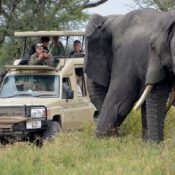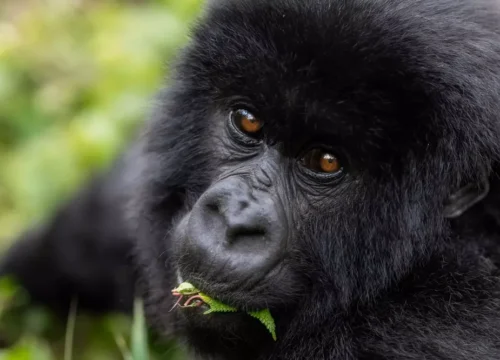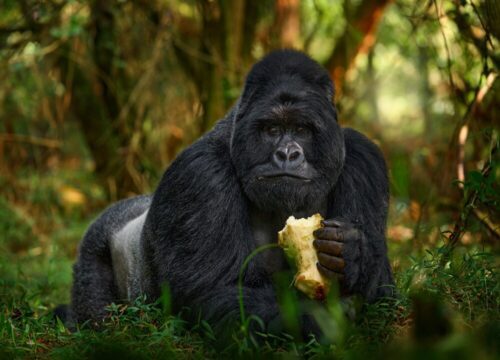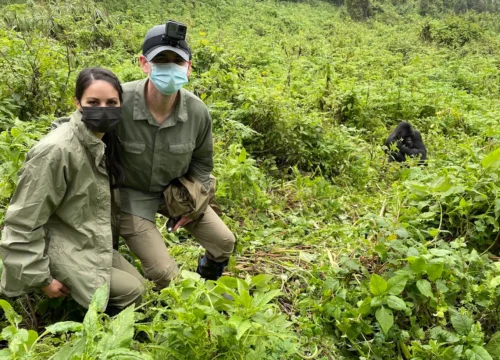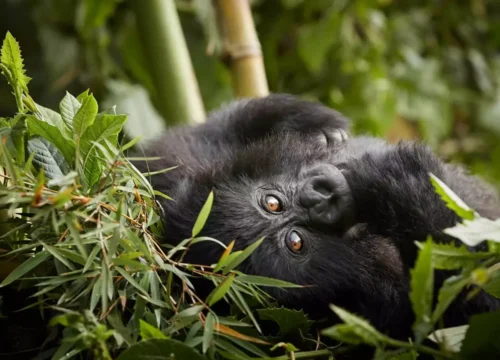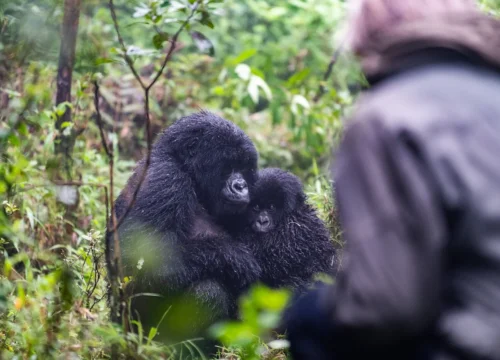Pilanesberg Game Reserve
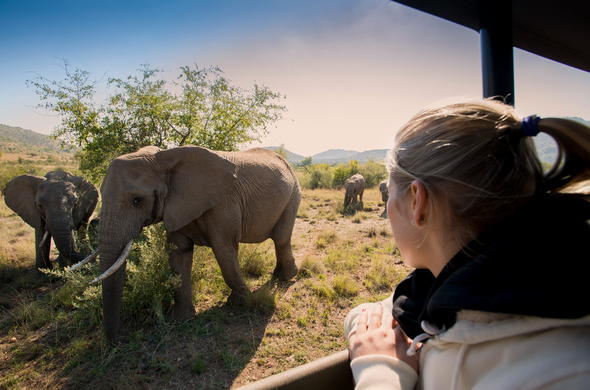

Pilanesberg Game Reserve Overview
The Pilanesberg Game Reserve §has a lovely setting and plenty of wildlife. Set in the eroded remnants of an ancient volcano, the Pilanesberg is a very scenic Big Five destination. The fully fenced park is well stocked but might lack wilderness appeal to purists. Only a three-hour drive from Johannesburg, it makes a very attractive weekend option.
Pilanesberg Game Reserve Pros & Cons
- Good wildlife viewing with all of the Big Five
- Beautiful scenery formed by ancient volcanic activity
- Lots of accommodation options for different budgets including self-catering
- Malaria-free
- Close to Johannesburg and Pretoria
- Next to Sun City Casino and entertainment park
- Big cat sightings are hit-and-miss
- Special sightings can get very crowded
- Fully fenced and totally stocked, lacking wilderness appeal
Pilanesberg Game Reserve Wildlife
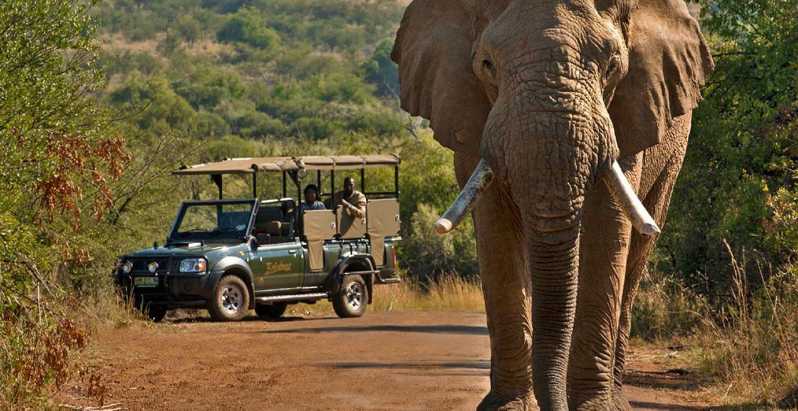
Pilanesberg Game Reserve is home to the Big Five and offers quite good wildlife viewing. Elephant is abundant, and white rhino is common. All big cats are present, but you will need some luck to spot any. Aside from the Big Five, you can expect to see giraffe, zebra, wildebeest and many antelope species.
Pilanesberg Game Reserve Scenery
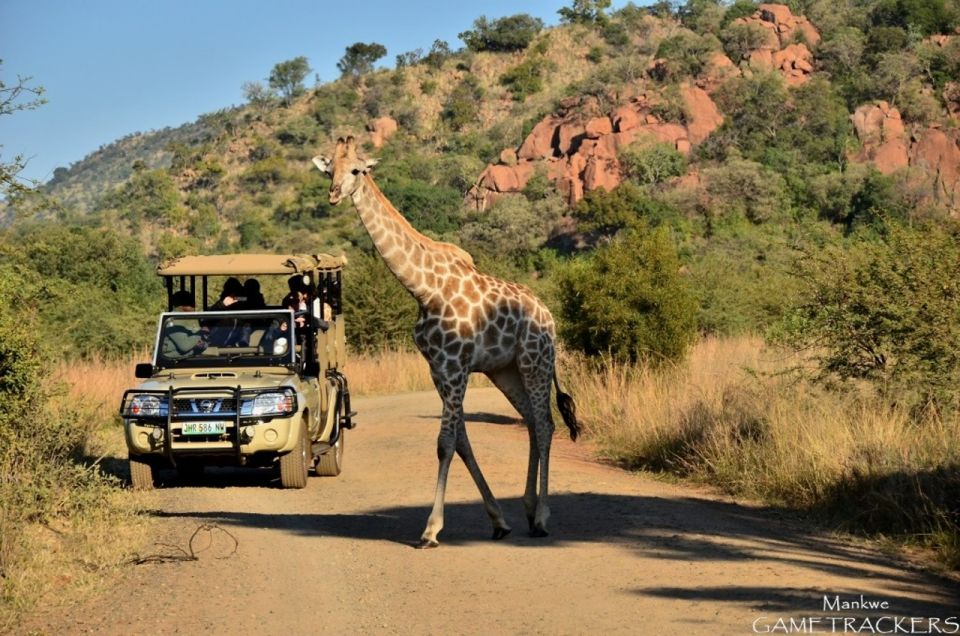
The Pilanesberg’s concentric hills, interspersed with grassy valleys, give it a picturesque natural beauty. This “onion-like” structure was formed by volcanic activity over 1300 million years ago. Mankwe dam is a great place to see animals coming to drink at sunset. A glimpse into the history of the Batswana people can also be found in one of the interesting iron-age archaeological sites in the reserve.
Pilanesberg Game Reserve Weather & Climate
Pilanesberg Game Reserve has a typically hot summer (October to April). But as this is the region’s Wet season, the heat tends to get softened by afternoon rains. Everything is reversed in the Dry season or winter (May to September) when the rain vanishes along with the heat. In fact, it can get pretty cold when the sun disappears from the sky. The humidity stays low year-round.
Best Time To Visit Pilanesberg Game Reserve
The park is at its greenest during the Wet season (October to April), but the drier months (May to September), with their consistently sunny weather, are best for wildlife viewing as the animals are easier to spot amidst the depleted vegetation.
Wildlife & Animals
The Pilanesberg Game Reserve has healthy populations of all of the Big Five animals. Elephant and White rhino are particularly common. Black rhino also occurs but is rarely seen. As with any reserve that doesn’t allow off-road driving and has thick vegetation, cat sightings are hit-and-miss. There is plenty of general plains wildlife around to keep game drives interesting.
Wildlife Highlights
The Pilanesberg Game Reserve is a good place to see the rare nocturnal brown hyena. Night drives will give you the best chance to encounter these shy but inquisitive creatures. Also, keep an eye out for serval, and lucky visitors might come across a pack of wild dog. One of the more unusual antelope species that roam the reserve is the fastest of Africa’s antelopes, the tsessebe.
Best Time for Wildlife Viewing in Pilanesberg Game Reserve
The Dry season (June to September) is best for wildlife viewing in Pilanesberg Game Reserve. The drought thins the foliage creating a better view, and animals congregate around and drink at permanent water sources.
Birds in Pilanesberg Game Reserve
The Pilanesberg Game Reserve area is an excellent venue for bushveld birding, with more than 300 species recorded. A typical day may yield 100 species or more in the summer months from November to April when migrants are present. For close-up viewing and photography, you can visit the walk-in aviary with over 80 species of indigenous birds. The self-guided camp walk and bird shelters are also highly recommended for bird watching.
Birding Specials–Treats for Avid Birders
- African crake
- African cuckoo
- African grass owl
- African red-eyed bulbul
- African spoonbill
- Cape vulture
- Green sandpiper
- Kalahari scrub robin
- Lappet-faced vulture
- Magpie shrike
- Marico flycatcher
- Osprey
- Red-billed oxpecker
- Red-chested flufftail
- Rufous-crowned roller
- Rufous-naped lark
- Sabota lark
- Shaft-tailed whydah
- Southern pied babbler
- Speckled pigeon
- Verreaux’s eagle
- White-backed mousebird
- White-backed vulture
Best Time for Bird Watching in Pilanesberg Game Reserve
In general, Pilanesberg Game Reserve is great for bird watching year-round. November to April is the prime time because the migrant species are present. If it’s general wildlife viewing that you’re interested in, the driest time of year (June to September) is best.
Best Time To Visit Pilanesberg Game Reserve
The best wildlife viewing in the Pilanesberg is in the dry winter months from May to September. The vegetation thins out as the ground gets drier, and animals tend to congregate around permanent water sources making them easier to spot.
Best Time: May to September (Dry season)
High Season: October to April (The park is busier, especially during school holidays)
Low Season: May to September (This is the best time for wildlife viewing)
Best Weather: April to May and September to October (Mild weather and little rain)
Worst Weather: May to August (Chilly mornings and nights) and December to February (Hot and afternoon rain)
May to September –Dry Season – Winter
- Best time for viewing wildlife
- Little rainfall and clear skies
- Low season means fewer tourists
- Cold nights and mornings
- Hazy, dusty atmosphere
October to April –Wet Season – Summer
- Landscape and scenery is delightful
- There are newborn animals
- Migratory birds are present
- The Dry season is better for wildlife viewing
- There will be crowds in the park, especially during school holidays
- Afternoon temperatures are high
Weather & Climate
Pilanesberg Game Reserve is located within an area of summer rainfall. Winter (May to September) is the Dry season and has mild daytime temperatures and cool nights. Warm clothing is recommended for night and early morning game drives. The reserve is located within the southern hemisphere and so experiences summer and winter at opposite times to Europe and North America.
Dry Season–May to September – Winter
There is virtually no rainfall during winter and the humidity is very low. These drought-like conditions cause foliage to thin and animals are drawn to permanent water sources, making them easier to see.
- May – Temperatures gradually drop, marking the beginning of winter. Average temperatures vary from 6°C/43°F in the mornings to 23°C/73°F in the afternoons.
- June, July & August – Warm clothes are essential for the cold mornings (5°C/41°F on average). Skies will be sunny and clear with daytime temperatures averaging 20°C/68°F.
- September – Average temperatures are a mild and pleasant 26°C/79°F during the day with cooler mornings (12°C/54°F).
Wet Season–October to April – Summer
Regular rains break up the heat. They usually come in the form of afternoon storms. Average daytime temperatures are around 30°C/86°F. Because of the low humidity, the heat is less of a burden when compared to the coastal regions.
- October & November – It gets warmer, and the first rains clear the haze in the sky. It rains more as the season progresses. Temperatures range from a typical 16°C/61°F in the morning to 29°C/84°F in the afternoon.
- December, January & February – December and January are the wettest months, characterized by torrential downpours in the afternoon. Daytime temperatures are typically around 31°C/88°F.
- March & April – Rainfall will decrease in March, and it slowly gets colder. This continues in April, which has lovely, clear weather and few clouds. The nights get a bit colder at about 12°C/54°F. Daytime temperatures are pleasant at around 29°C/84°F.
Getting There
The main point of entry for most travelers to South Africa is O.R. Tambo International Airport (JNB) in Johannesburg. You can rent a car there to drive to Pilanesberg Game Reserve. The 200km/124mi drive is very scenic and takes less than 3 hours*.
There are currently no scheduled flights to Pilanesberg.
Airlines & Ticket Prices
Please check Skyscanner to see which airlines can take you to O.R. Tambo International Airport (JNB), and what tickets would cost.
- www.skyscanner.com
Malaria & Safety
Pilanesberg Game Reserve is, in our opinion, a safe place for travelers. All South African parks and reserves are basically free of crime. As all over the world, there is always some crime in cities, but you’ll be sheltered from that on an organised tour. As long as you take normal safety precautions when visiting urban places, there is nothing to worry about (see ‘Cities & Other Urban Areas: Safety Precautions’ below). The vast majority of travelers in South Africa have a crime-free visit.
Malaria-Free & Vaccinations
There is no malaria in Pilanesberg GR, so antimalarial medication isn’t required. Only in the north eastern part of South Africa, including Kruger, is there a small malaria risk. Several vaccinations are advisable when traveling to South Africa (consult your local healthcare professional)
Wildlife Viewing
Wildlife viewing is very safe as long as you listen to the instructions of your guide. Self-drive visitors should take note of the reserve’s rules and take note of the ‘Wildlife Viewing Safety Precautions’, below. Incidents with wild animals are extremely rare.
Want To Visit Kgalagadi TP?
INQUIRE NOW
GENERAL INFORMATION ON A SOUTH AFRICA SAFARI
ENTRY REQUIREMENTS:
All visitors to South Africa must have a valid passport with at least 4 consecutive blanks pages. Any applicable visa and/or relevant documentation are the responsibility of the traveller. For further information on Visa requirements visitors are advised to contact their nearest South African Embassy or Consulate.
LANGUAGE:English
TIME: GMT +3
VOLTAGE: 220 Volts/AC50Hz. Sockets are UK style, 3 pin square plugs. Power is from the government in the city/major towns and generator with inverter back up in the Safari Lodges and Camps.
CURRENCY: Foreign currency must be changed at the Bank, Bureau de Change, and Hotel/Safari lodge/Camp/Resort. Major Credit Cards, Master card, Visa, American Express, are usually accepted throughout the country. Where credit cards are accepted, the payment will normally be recorded in US$ regardless of the card’s default currency.
CLOTHING: Dress is mainly informal and should be comfortable as well as practical. Something warm should be brought along for early morning and evenings. Safari clothes are available from hotels/lodges/camps.
BAGGAGE: Where possible, travel light. Baggage space on safari is limited to medium suitcase or soft bag per person plus reasonable amount of hand luggage. There is 15 Kilogram per person limit on all flights to the wildlife sanctuaries. Excess luggage must be stored in your arrival hotel.
WATER: You will find many different of opinion of what is safe and what is not. We recommend for peace of mind, to drink local Bottled Mineral water. It is important to drink plenty of water especially during the hotter months. We would recommend that guests drink at least 2 to 3 liters of water per day to limit the effects of dehydration.
HEALTH; East Africa is a safe and secure destination; however, it is a good idea to take a few precautions. Kindly consult your GP or local doctor at least 6 weeks before you travel, with regards: Malaria prophylactics. East Africa is a known malaria area and preventive measures are essential. You are advised to take one of the recommended anti-malarial drugs. Be sure to wear long sleeved shorts and trousers after sunset and spray the exposed parts of your body with a mosquito repellent spray Remember to protect yourself from direct sun rays with sunscreen cream or safari hat.
DIETARY REQUIREMENTS: For those guests with specific dietary requirement, please ensure we are notified prior to travel
GRATUITIES: As a guideline and dependent on how happy you are, we would suggest the following: The General Hotel/Lodge/Camp Staff – Approximately U$ 10.00 per person per day Driver Guides – Approximately US$ 15.00 to US$ 20.00 per person per day.
PHOTOGRAPHY: Please be careful when photographing public buildings, airports, bridges, the national flag and people in uniform. Ensure that you have sought permission before photographing local people and their villages. If in doubt, please check with your guide.
Book a Customized Safari
Read about
10 Things you Should NOT DO on an African Safari.
What to expect on a safari in Uganda.
Bwindi Impenetrable National Park
How to Choose the Best Tour Operate for Your Safari in Africa
12-Day Gorilla Tracking in Bwindi
Some of our Gorilla and wildlife Safaris
1 Day Jinja Ultimate tour Experience
1 Day White Water Rafting in Jinja
3 Days Bwindi Gorilla Habituation via Rwanda
3 Day Birding Safaris and Photography in Uganda
3 Day Safari to Queen Elizabeth National Park
3 Day fly in Gorilla Trekking Safari from Masai Mara
3 Day Grand Gorilla Trekking Safari
4 Day Chimpanzee and Gorilla Trekking Safari
Recent Posts
Last Minute Deals
Quick booking process
+49 1575 4711313



